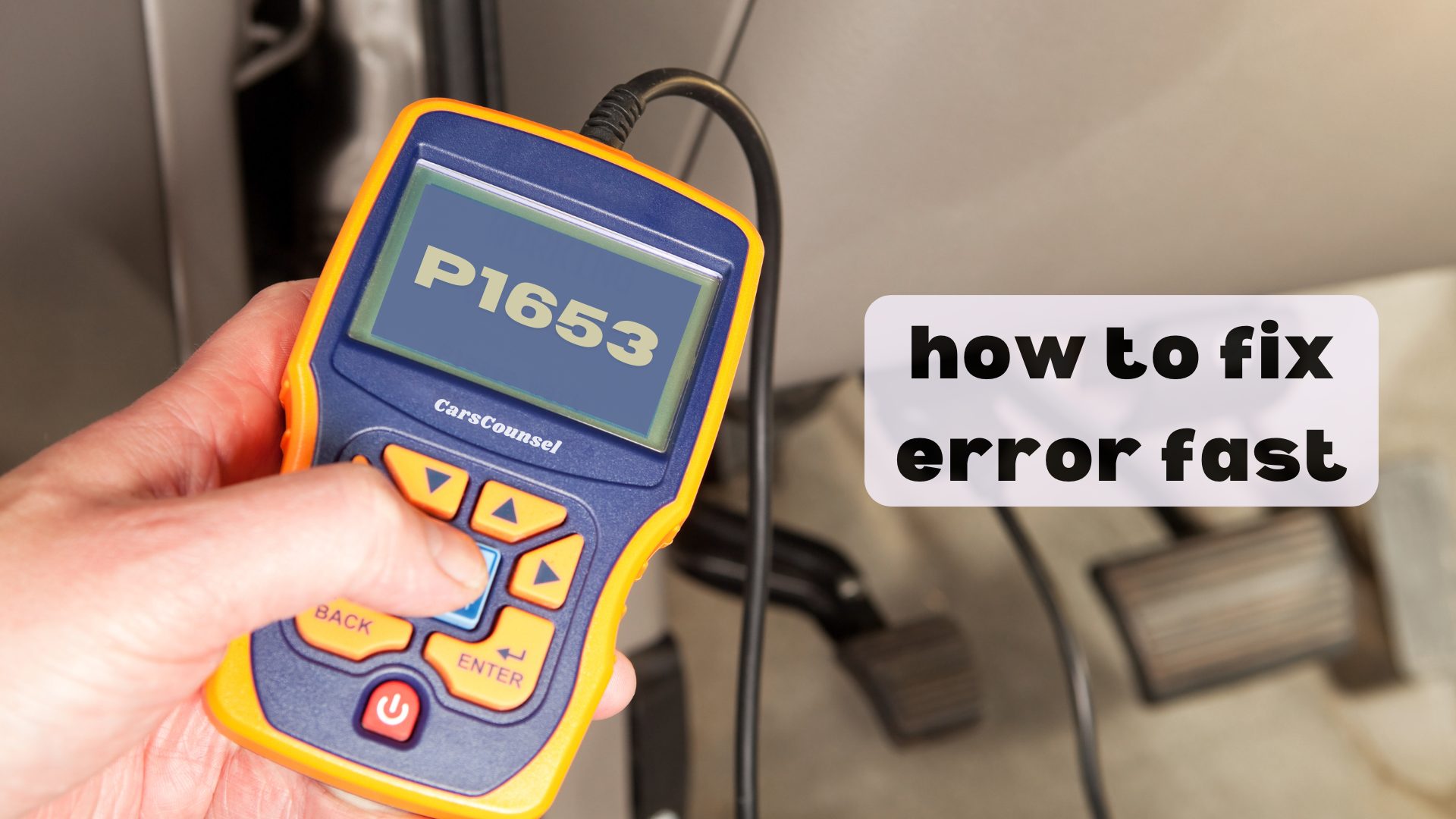You’re faced with the P1653 code, which means your vehicle’s EGR Vent Solenoid Control Circuit is malfunctioning. This vital system helps reduce nitrogen oxide emissions by recirculating exhaust gases back into the engine. But what’s causing the issue? Is it a faulty EGR Vent Solenoid, wiring problems, or something else entirely? The symptoms are clear – reduced engine power, rough idling, and stalling – but the solution isn’t so straightforward. To get your engine running smoothly again, you’ll need to dig deeper and identify the root cause of the problem, which is essential to resolving the issue and getting your vehicle back on the road.

Quick Navigation
Key Takeaways
- The P1653 code indicates a problem with the EGR Vent Solenoid Control Circuit, affecting engine performance and emissions.
- A faulty EGR Vent Solenoid is a common cause of the P1653 code, which can be triggered by wiring issues, ECM communication problems, or vacuum leaks.
- Symptoms of a faulty EGR Vent Solenoid include reduced engine power, rough idling, stalling, increased fuel consumption, and Check Engine Light illumination.
- Diagnosing the P1653 code issue involves using a scan tool to retrieve trouble codes and live data, reviewing freeze frame data, and inspecting the EGR Vent Solenoid’s electrical connections.
- Repairing the EGR Vent Solenoid circuit involves inspecting and repairing or replacing damaged wires, cleaning or replacing corroded terminals, and ensuring proper solenoid operation and function.
Code P1653 Description and Purpose
When your vehicle’s onboard computer triggers a P1653 code, it’s alerting you to a problem with the EGR Vent Solenoid Control Circuit.
The EGR system, which includes the Vent Solenoid, plays a critical role in reducing nitrogen oxide emissions by recirculating exhaust gases back into the engine’s intake manifold.
This process, known as the EGR function, is essential for minimizing the environmental impact of your vehicle.
The EGR system’s importance can’t be overstated, as it directly affects emissions.
Common Causes of the P1653 Code
Your vehicle’s P1653 code is often triggered by a faulty EGR Vent Solenoid, which is a critical component of the EGR system.
This solenoid controls the flow of exhaust gases recirculated back into the engine’s intake manifold, reducing nitrogen oxide emissions.
However, it’s not the only culprit behind the P1653 code. Wiring issues, such as shorts or opens, can also cause the error code to appear.
Additionally, ECM communication problems, vacuum leaks in the EGR system, and carbon buildup in the EGR valve can all trigger the P1653 code.
It’s essential to diagnose the specific cause to guarantee accurate repair.
Symptoms of a Faulty EGR Vent
With a faulty EGR Vent Solenoid, you can expect to experience a range of unpleasant symptoms that’ll have you scratching your head and wondering what’s going on under the hood.
Your EGR Performance will suffer, and you’ll notice reduced engine power and efficiency. The faulty vent solenoid will disrupt the flow of Exhaust Gases, causing your engine to run rough, idle poorly, or even stall.
You might also notice increased fuel consumption, which can be costly and environmentally unfriendly. Additionally, a faulty EGR Vent Solenoid can cause your Check Engine Light to illuminate, and you may fail an emissions test.
Furthermore, a faulty EGR Vent Solenoid can lead to more severe engine problems down the line if left unchecked.
Diagnosing the P1653 Code Issue
Now that you’re aware of the symptoms of a faulty EGR Vent Solenoid, it’s time to tackle the P1653 code issue head-on.
To diagnose the problem, you’ll need to use a scan tool to retrieve trouble codes and live data.
This will give you a better understanding of the EGR system overview and help you identify the root cause of the issue.
Here are some scan tool tips to keep in mind:
- Use the scan tool to monitor the EGR Vent Solenoid’s operation and check for any faults or malfunctions.
- Review the freeze frame data to see the engine’s conditions when the code was set.
- Use the scan tool to perform a bi-directional test to verify the solenoid’s operation.
Inspecting the EGR Vent Solenoid
Inspecting the EGR Vent Solenoid requires a thorough examination of the component and its connections.
You’ll need to check the solenoid’s electrical connections for signs of corrosion, damage, or wear. Make sure they’re clean and secure.
Next, inspect the solenoid itself for any signs of physical damage or carbon buildup. Check for proper solenoid maintenance, ensuring it’s free from debris and functioning correctly.
You should also verify that the solenoid is receiving the correct voltage and ground signals. A faulty electrical connection or solenoid can prevent the EGR system from functioning properly, leading to issues with engine performance and emissions.
Repairing the EGR Vent Solenoid Circuit
Faulty electrical connections or corrosion in the EGR Vent Solenoid circuit can prevent the EGR system from functioning correctly, leading to issues with engine performance and emissions.
To repair the EGR Vent Solenoid circuit, you’ll need to identify and address the root cause of the problem.
- Inspect the circuit wiring for signs of damage, corrosion, or wear. Repair or replace damaged wires as needed.
- Check the solenoid’s electrical connections for loose or corroded terminals. Clean or replace them if necessary.
- Use a multimeter to test the circuit voltage and guarantee it’s within the specified range.
Clearing the P1653 Code and Reset
Once you’ve identified and addressed the root cause of the P1653 code, it’s time to clear the code and reset the Engine Control Module (ECM).
You’ll need to follow the reset procedures outlined in your vehicle’s repair manual or use a scan tool to complete the process. If you replaced the faulty EGR Vent Solenoid, verify it’s properly installed and connected.
After resetting the ECM, the P1653 code should be erased, and your vehicle’s engine should return to normal operation. Remember to double-check your work to avoid any additional issues.
Additional Diagnostic Testing Steps
When troubleshooting the P1653 code, you’ll likely need to perform additional diagnostic testing steps to verify the issue is fully resolved.
To guarantee the EGR system is functioning at peak levels, you should perform the following tests:
- EGR System Refining: Verify that the EGR system is properly calibrated and fine-tuned for your vehicle’s engine. Consult your repair manual for specific procedures.
- Solenoid Calibration: Calibrate the EGR Vent Solenoid to guarantee it’s functioning within the recommended specifications. This may involve adjusting the solenoid’s timing or flow rate.
- Vacuum Leak Testing: Perform a vacuum leak test to identify any leaks in the EGR system, which can affect the solenoid’s performance and overall system operation.
Cost to Fix the P1653 Code Issue
In conjunction with diagnosing and repairing the P1653 code, it’s essential to weigh the cost implications of fixing the issue.
You’ll need to ponder repair estimates and budget constraints to determine the best course of action. Replacing a faulty EGR Vent Solenoid can cost between $150 to $300, but additional components may need to be replaced, increasing the total repair cost.
It’s vital to prioritize repairs based on your budget and the severity of the issue. Be prepared to allocate funds for potential additional repairs, and research different repair options to find the most cost-effective solution.
Additional Resources for Repair
You’ve got a solid understanding of the P1653 code issue and its associated repair costs, now it’s time to investigate additional resources to help you explore the fix.
1. Repair Guides: Websites like Engine-Codes.com and Factory Service Manuals provide detailed guides and diagrams to aid in your repair.
These resources can help you pinpoint the exact problem and walk you through the repair process.
2. Online Forums: Online forums dedicated to your vehicle’s make and model can be a valuable resource.
You can connect with other owners who’ve experienced the same issue and learn from their experiences.
3. Technical Service Bulletins: Check for Technical Service Bulletins (TSBs) related to the P1653 code, as they may provide additional information on the diagnosis and repair of the issue.
More OBD-II Codes
Frequently Asked Questions
Can I Drive My Car With the P1653 Code Illuminated?
You can drive your car with the P1653 code, but be aware of driving risks, such as reduced engine performance and rough idling, which may lead to safety concerns like stalling or loss of control, especially on the highway.
Will a Faulty EGR Vent Solenoid Affect My Car’s Fuel Efficiency?
“An ounce of prevention is worth a pound of cure.” Yes, a faulty EGR vent solenoid will likely affect your car’s fuel efficiency, leading to increased fuel consumption, and may also impact engine performance, causing reduced power and rough idling.
Is It Possible to Clean the EGR Vent Solenoid Instead of Replacing It?
You can try cleaning the EGR vent solenoid as part of your solenoid maintenance, but it’s vital to follow proper EGR troubleshooting procedures to guarantee effective cleaning and avoid damaging the component.
Can I Reset the ECM Without Clearing the P1653 Code First?
Coincidentally, you’re wondering if you can reset the ECM without clearing the P1653 code first. You shouldn’t, as it won’t fix the underlying solenoid failure issue, and the code will likely return, causing continued engine performance problems.
Will a P1653 Code Trigger an Immediate Emissions Test Failure?
You’re wondering if a P1653 code will trigger an immediate emissions test failure. According to OBD II protocols, a malfunctioning EGR system will illuminate the Check Engine Light, but it may not necessarily fail the test immediately, as test failure criteria vary by state and jurisdiction.
Conclusion
If you’ve encountered the P1653 code, don’t delay addressing it. A faulty EGR vent solenoid can lead to serious engine performance issues and environmental harm. For instance, a 2012 Ford F-150 owner in California failed to repair their EGR vent solenoid, resulting in a failed emissions test and a costly repair bill. By promptly diagnosing and fixing the P1653 code, you’ll restore your engine’s power, reduce emissions, and avoid expensive repairs down the road.

